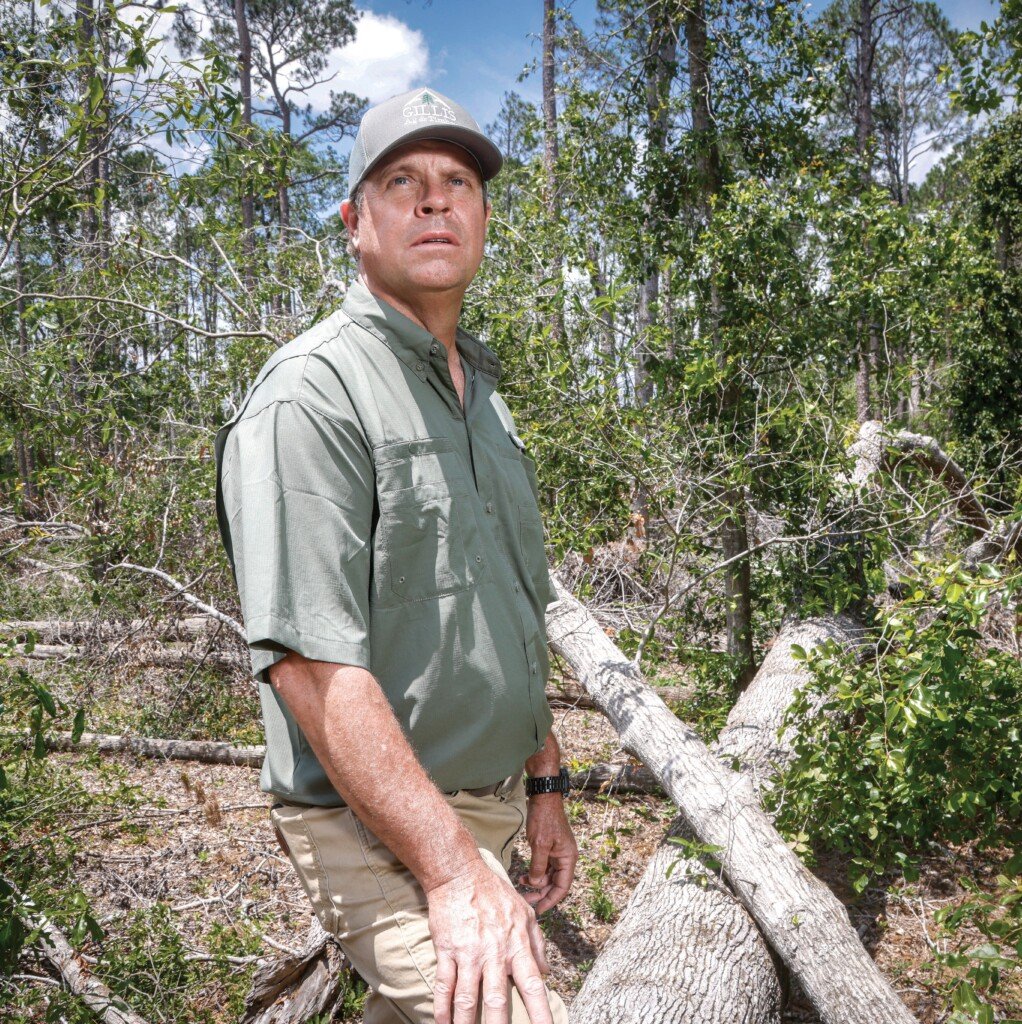Fighting for Farm Futures
Farmers try to recover after Hurricane Helene wiped out timber and livelihoods in a single night, and they face a new threat with bird flu.

The Storm’s Aftermath: Ben Gillis, owner of Gillis Ag & Timber, at his tree farm in Soperton. Photo credit: Frank Fortune
Ben Gillis will never forget the chilling phone call from his father, Hugh, the morning after Hurricane Helene blasted Georgia in September 2024.
“He simply said, ‘Ben, it’s all gone.’ And those words hit a lot harder than the hurricane’s 100 mile-an-hour winds,” says Gillis, whose family lost 60% of the timber on their 15,000 acres in Soperton in one night of devastation.
The hurricane caused 37 deaths in Georgia and ripped open a multibillion dollar wound in the heart of the state’s agriculture industry as millions of trees snapped like toothpicks, poultry houses were smashed by monstrous winds, and livelihoods built over decades were swept away in an instant.
Damage from the storm to the state’s agriculture industry has been estimated at more than $5.5 billion, up to almost $6.5 billion. About $1.3 billion was lost in timber. Those figures also reflect the impact on supporting businesses and the cost of recovery and restoration.
Then, in the wake of the storm, another natural disaster emerged to pose a potential threat to Georgia’s largest agricultural engine – the more than $7 billion poultry industry. The encroachment of avian (bird) flu is forcing state leaders to take new protective measures.

Hard Hit: Ben Gillis says his tree farm lost 60% of its 15,000 acres of timber in Hurricane Helene. Photo credit: Frank Fortune
“Poultry makes up more than a third of Georgia’s agricultural economy,” says Tyler Harper, Georgia’s commissioner of agriculture. “Ensuring that we keep avian influenza at bay is critical not only for our poultry industry, but our state economy.”
Between the chickens and the trees, Harper and his colleagues have their hands full of natural phenomena, and it can all feel a bit sticky.
“Whether it’s timber operators losing generations of forest to a hurricane or poultry producers affected by the storm, or battling avian flu, we’re facing some unprecedented challenges across our agricultural sectors in Georgia,” says Harper, who still farms the same piece of land that has been in his family for almost 150 years.
For Ben Gillis, the roots run even deeper.
“My family migrated here in the early 1800s with land grants when Georgia was trying to settle this region,” says Gillis, 52, owner of Gillis Ag & Timber, with emphasis on the timber. “When that hurricane hit, generations of my family’s work got erased overnight.”
Blown Away
Georgia’s agriculture industry is tied closely to the land lottery system that brought the Gillis family to Treutlen County. After the Creek Nation was defeated by Andrew Jackson in 1814, and members of the Creek and Cherokee nations forcibly removed, the lottery system distributed the newly seized land to farmers. In the 28 years the land lottery system operated, Georgia sold about 75% of the state to approximately 100,000 families and individuals.
Back then, timber enterprises were mostly small-scale and localized. Forests were cleared for farmland and to supply nearby towns with wood for homesteads and basic goods. Logging meant long, hard hours of labor-intensive work as settlers felled trees – mostly longleaf pine and hardwoods – for immediate use or even commercial sale, often sent down rivers to mills or the ports.
The oldest family grave on the Gillis property – the family still has its original 400 granted acres – is from 1829.
“Since then, we’ve pretty much been doing ag and timber and the land has delivered a living for our family for all those generations,” says Gillis. “Things have transitioned, though. We no longer do row crop agriculture. For us, it’s been straight timber.”
It’s been that way since the late 1990s for Gillis, who still owns row crop land but leases it out to other farmers. Timber has been a good income source for the family for a long time.
“At one time, my great granddaddy had 38,000 acres of timberland,” says Gillis. Helene’s high winds knocked down thousands of acres of slash, longleaf and loblolly pine, as well as hardwood trees, on the family’s farm. “The storm had no favorites. It got them all.”
Helene exposed the fragility of what had seemed like a stable investment, creating not just economic loss, but posing an existential threat.
“We’ve been tree farmers for years and we’ve taken it seriously – we converted highly erodible land to pine trees, participating in the Conservation Reserve Program in the 1990s,” Gillis says. “We thought we had a secure and safe investment.”
“A healthy, sustainable managed forest is directly tied to healthy markets, not only in Georgia, but across the country.” – Tim Lowrimore, president and CEO, Georgia Forestry Association
Uncertain Economics
Gillis always understood that the economics of timber farming are a long-term proposition. “It takes 20 to 25 years to grow a crop of trees,” he says. “Your first meaningful cash comes around year 15, and that basically just covers your planting costs. The real money comes around year 25.”
For many older landowners, those decades of careful cultivation have been wasted by a storm the likes of which that part of Georgia had not experienced since the 1800s, according to the National Weather Service. Gillis knows a 94-year-old farmer and his wife in Emmanuel County who lost 400 acres – their primary retirement income – overnight.
“There’s no replacing that,” Gillis says.
The hurricane swept through almost 9 million acres, severely damaging around 1.5 million acres in Georgia, an area often referred to as the “wood basket of the nation.”

Supporting Landowners: Tim Lowrimore, president and CEO of the Georgia Forestry Association. Photo credit: Matt Odom
“There aren’t a whole lot of places in our country that serve the diversity of markets or have the productivity we have in Georgia,” says Tim Lowrimore, president and CEO of the Georgia Forestry Association, a statewide nonprofit organization that advocates for sustainable forest management and supports the economic interests of Georgia’s landowners and timber industry.
“A healthy, sustainable managed forest is directly tied to healthy markets, not only in Georgia, but across the country,” Lowrimore says. “These forests have to have value for landowners to continue to invest in timber.”
And a damaged forest represents a huge loss in value. Gillis says the fallen timber draws about 25% to 30% of what market value would have been. Some landowners are getting nothing, or maybe just enough to cover the cost of cleaning up the fallen timber.
Gillis is old enough to wonder if he wants to commit to another 25-year timber cycle; his kids are too young to take over the operation. The economics of it all have become very uncertain – not only for farmers and their families, but for entire communities.
Retirement in Ruins
When the hurricane smashed into Vann Wooten’s farm near Hazlehurst, it obliterated more than buildings and three decades of agricultural investment.

Uncertain Future: Vann Wooten, vice chair of the Jeff Davis County Board of Commissioners, says he lost 18 poultry houses when the hurricane slammed his farm near Hazelhurst. Photo credit: Frank Fortune
“It was kind of like going to work one day and the boss telling you, ‘OK, you don’t have a job anymore, and we’re taking your retirement benefits with us, too,’” says Wooten, who is vice chair of the Jeff Davis County Board of Commissioners. “That hurricane took away my retirement plan.”
Wooten had a family operation consisting of 18 poultry houses that generated $300,000 to $400,000 annually – all of it gone with the wind, reduced to feathers and rubble.
“I didn’t have insurance on my poultry houses. Too expensive,” Wooten says matter-of-factly.
The chicken houses that cost $94,000 to build in 1993 would cost about half a million dollars to replace now, evidence of how brutal the economics of farming can be. A tractor that Wooten purchased in 1998 for $78,000 can easily go for four to five times that amount these days.
Wooten raised chickens for Pilgrim’s Pride, one of the largest poultry sellers in the world. While the company’s profits have increased dramatically, contract farmers have experienced razor-thin financial margins. Farmers’ pay per pound of chicken has decreased in the years Wooten has been in the business.
For years, the relationship with Pilgrim’s Pride has been layered in complexity. Wooten had been working with Gold Kist, which was purchased by Pilgrim’s Pride in 2009. Not long after, the company’s local plant closed for two years, which meant Wooten wasn’t producing for two years.
“We’ve been beat up in the chicken business,” says Wooten. “But I’m not giving up. I’ve never been a giving-up guy. I’m going to make something happen, and I’m going to have hope that our federal government can help us.”
Avoiding an Outbreak
As if Helene’s devastation wasn’t enough, poultry growers in Georgia are facing another threat – the arrival of avian influenza.
“I know it’s gotten closer every year, and this year it got to Georgia,” says Wooten, whose son and son-in-law also raise chickens and lost $1.3 million in poultry house damage but are still operating. “We’ve been unlucky with the storm, but I’m glad the flu hasn’t reached us yet.”

Emergency Operation: Tyler Harper, commissioner of the Georgia Department of Agriculture, center, surveying cotton damage in Southeast Georgia with others. Photo credit: contributed
Any outbreak of avian flu has the potential to be catastrophic. Georgia is the top broiler-producing state in the country, responsible for over a third of the nation’s chicken supply. Highly pathogenic avian influenza, known to scientists as HPAI or H5N1 but to the public as bird flu, is highly contagious, causing severe illness and death in poultry. Some strains can infect other farm animals, like dairy cattle.
“Poultry is the heartbeat of our agricultural economy – it isn’t just a commodity in Georgia,” says Ag Commissioner Harper. “Our entire agricultural economic ecosystem depends on these birds staying healthy.”
Raising poultry takes years of careful breeding and management. A disruption in the delicate process could have sweeping effects. That’s why Harper has taken an aggressive approach to agricultural protection, transforming the Department of Agriculture’s emergency management capabilities.
“We don’t just respond to agricultural emergencies, we try to anticipate them,” says Harper, who established an Agricultural Emergency Operations Center that allows rapid, collaborative responses to emergencies like the avian flu. Fortunately for the state’s poultry industry, the EOC’s first test seems to have been a success.
The first cases of avian flu in a commercial setting in Georgia history hit Elbert County in January, involving two commercial farms. Within 30 minutes of notification, late one afternoon, the EOC was up and running. Soon, agricultural law enforcement officers were locking down the sites and controlling access to the affected area as strict biosecurity measures were implemented.
“Within five hours, we had boots on the ground in Elbert County,” Harper says. “Within 12 hours, all the farms in the quarantine zone were quarantined, and in less than 48 hours the virus was completely contained.”
In the end, three flocks and 205,000 birds were impacted – compared to more than 700 flocks and about 167 million birds nationwide.
“Biosecurity isn’t just a buzzword for us, it’s a promise, because when you’re dealing with the avian flu, you’re not just managing a virus – you’re protecting an entire state’s economic backbone,” Harper says. “And these aren’t just industries – they’re family legacies, retirement investments and the lifeblood of rural communities. Our job is to be prepared, respond quickly and ensure that a natural disaster or a viral outbreak doesn’t wipe out years of hard work and dedication.”
Paying for the Damage
Wooten is facing several dilemmas – one personal, and one that could affect his county’s financial future. Like much of the region, Jeff Davis County was pummeled by Helene, which hammered the rural county’s tax base.

Quick Response: Agriculture Commissioner Tyler Harper, right, with Taylor and Arren Moses at Moses Pecan farm, which lost 80% of its mature trees in Helene. Photo credit: contributed
“We receive anywhere from $400,000 to $600,000 a year just in timber taxes,” Wooten says. “That’s a substantial amount for us. Now I’m sitting here trying to figure out what we’re going to do three or four years down the line.”
Gov. Brian Kemp signed state legislation designed to help farmers and other Georgians hurt by the storm. One bill authorizes tax breaks to help agricultural and timber producers, while another improves consumer protections for homeowners seeking repairs after disasters. The budget includes nearly $863 million in storm-related spending. Much of it covers the state’s costs for cleaning up debris, rebuilding roads, repairing state buildings and other damage. Some of it covers state and local matching funds needed to obtain federal emergency relief.
Harper says farmers can apply for low-interest loans to repair structures, while timber owners can get grants to clean up fallen trees that have become a fire hazard. Altogether, Georgia legislators have approved about $1.2 billion this year for disaster cleanup and relief.
Meanwhile, the Trump administration is severely downsizing the Federal Emergency Management Agency and denied Georgia’s request to extend the deadline for local governments to apply for federal disaster assistance, despite ongoing cleanup efforts and appeals from state officials. The overwhelming “no” from the president has left a bad taste in the mouths of some people in a region that supported his election.
“Trump’s administration has put a hold on the things we asked for back in November, things that had already been approved,” Wooten says. “Now Trump and Elon Musk’s Department of Government Efficiency have kind of put the brakes on that. I think the administration has to figure out a way to help farmers and farm communities.”
“These aren’t just industries – they’re family legacies, retirement investments and the lifeblood of rural communities.” – Tyler Harper, Georgia commissioner of agriculture
Both Gillis and Wooten have been encouraged by the response of some in the federal government, notably U.S. Sen. Jon Ossoff, who has reached out to both men. In the days following the hurricane, Ossoff joined U.S. Rep. Austin Scott in leading a bipartisan group of lawmakers urging Congressional leadership to ensure disaster relief resources were made available.

Relief Request: U.S. Sen. Jon Ossoff testifies before the Senate Appropriations Committee in November 2024 about the need for disaster relief for Georgia farmers. Photo credit: contributed
“Georgia agriculture was devastated,” Ossoff says. “The numbers were staggering, but this wasn’t about numbers. It’s about families and rural communities, and the simple fact is that without help, many of these family farms will fold, and they may fold soon.”
Gillis, who says he welcomed the support of Ossoff and U.S. Rep. Rick Allen, who represents the 12th Congressional District, does not plan to fold what amounts to a 200-year-old family operation. But he may shift gears and find other uses for the family land.
“When you’ve got a 25-year investment that’s suddenly wiped away, and you get zero return, it’s hard to dive back in,” he says. “But look, if I’ve got 15,000 acres, and I can put 1,000 acres or so into solar energy, and there’s enough cash flow off of that to protect the other 14,000 acres and keep that family legacy, I’m okay with that.” 






